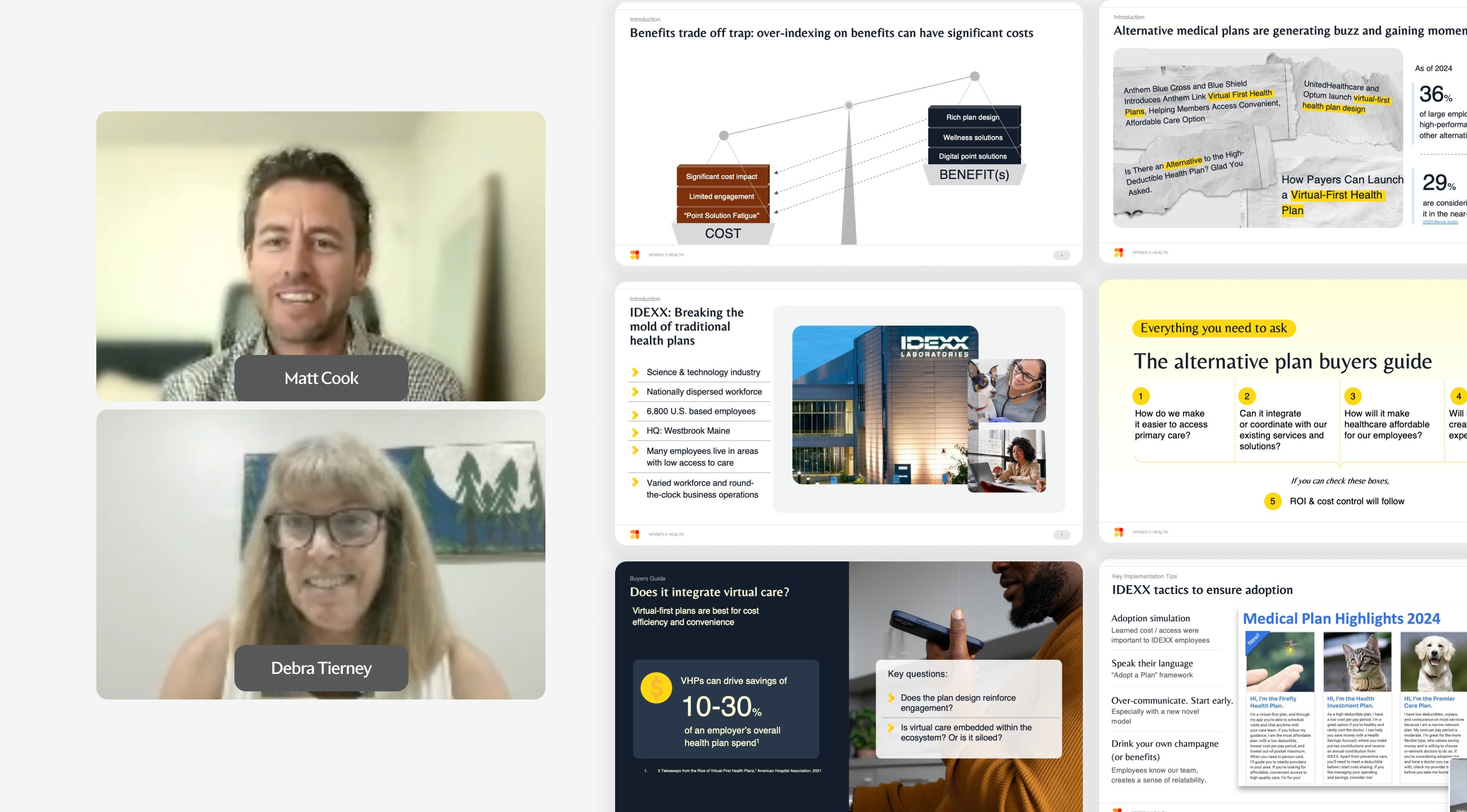Webinar Recap:
How Innovative Employee Health Benefits Maximize Affordability and Engagement
by Skylar Rolstad
Published July 26, 2024
Webinar Recap:
by Skylar Rolstad
Published July 26, 2024

Employers are ditching traditional health plans for virtual-first options. Why? The future of healthcare is here, and it goes far beyond virtual care. It's about creating a seamless ecosystem where convenience, comprehensive care, and personalized health plans come together as one.
On Tuesday, July 16, Matt Cook, Chief Commercial Officer at Firefly Health, invited Debra Tierney, Senior Benefits Manager at IDEXX Laboratories, a leader in pet healthcare innovation and Firefly Health client, for a conversation about her experience offering employees an alternative health plan, plus tactics for an effective rollout driving plan adoption. Debra discussed meeting employee needs, allowing members to live their healthiest lives, and attracting and retaining top talent.
Key takeaways from the webinar included:
Benefits managers such as Debra always seek to unlock value for employees and prioritize care that promotes convenience, longevity, and efficiency. An alternative health plan can help address employee needs that traditional plans offered by major insurance corporations can’t accommodate. Consider the following questions Matt and Debra explored Tuesday about whether an alternative health plan can maximize value, convenience, and employee wellness.
IDEXX employees work in locations across the country, so Debra found it important to work with a national healthcare provider in offering an alternative plan. A national provider allowed IDEXX to sidestep complicated intricacies involved in setting up plans with companies in each state where IDEXX employees live.
An alternative health plan allows companies such as IDEXX to be flexible in finding a plan that offers exactly what employees need without the complex web of contracts, pricing inefficiency and lack of transparency, and fragmentation often experienced by employers and employees with the benefits packages offered by major corporations.
Health plans tailored to employee needs can save money and make care more accessible. Overall cost of care proved to be the most important aspect of a new employee benefits package following a survey of IDEXX employees1. This finding allowed Debra’s team to position Firefly Health’s plan as a convenient and affordable option. Aside from insurance premiums, Debra also addressed the cost of copayments in finding an alternative plan, as lower copays allowed employees to save in another way.
Many people became more comfortable with telehealth during the COVID-19 pandemic, and the demand for virtual care will surely continue.
More than 80% of US counties are considered ‘medical deserts,’ where medical infrastructure is inadequate2. Virtual healthcare solutions can help members access care from anywhere.
However, telehealth done well doesn’t mean cursory, one-off appointments. Firefly Health’s health plan allows members to connect with a dedicated, readily available care team. “They understand you, and they’re going to be there when you need them most,” Matt said, explaining that an ongoing care team relationship helps members meaningfully address health goals and concerns while benefiting from the convenience of virtual modality.
This care team consistently meets with the patient, and navigates patients toward specialists with cost efficiency in mind and upfront price transparency.
Some employees may not fully engage with their present health plan, presenting inefficiencies and opportunities for employers to rethink plan offerings. Alternative options can be a good fit for employees of certain age groups or other demographics. For example, younger employees may be more comfortable with virtual care.
In Debra’s case, many frontline employees seldom booked primary care appointments. Many found it difficult to schedule and time-consuming to attend primary care appointments, but an alternative option allowed for convenient virtual care to take place of hours-long commutes to and from appointments.
Alternative health plans are new for employers and employees alike. IDEXX successfully encouraged a large cohort of employees to enroll in a new plan through a steady, consistent communications strategy that was carried out well before enrollment.
Introduce yourself to set up a conversation with Matt Cook, Chief Commercial Officer at Firefly Health, and learn more about how virtual care solutions geared toward meeting employee and financial needs can transform your organization’s employee wellness.
Today we’re in a place where we feel we’re offering high quality, high-impact benefits that support the well-being of them and their families. And we’re not done. This is an ongoing journey.